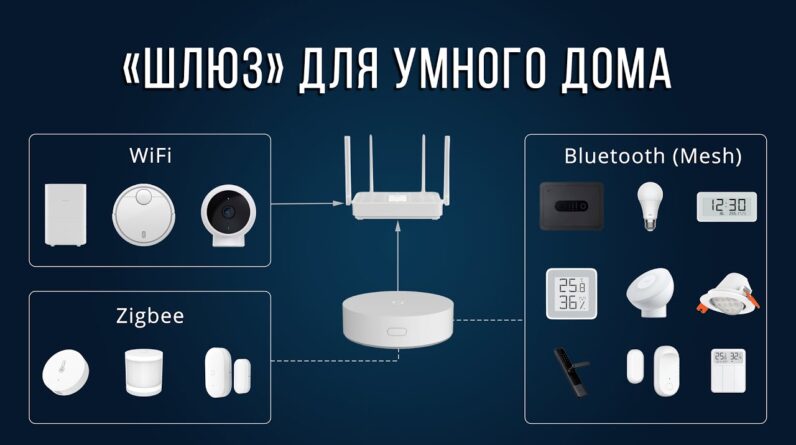
What is a "gateway" or "hub" of a smart home? Why and who needs it? What devices and scenarios can it control? Which version of the gateway should you choose? Let's deal with these issues together on the Xiaomi Smart Home channel. The smart home control center Mi Smart Home Hub, or as it is also called the Xiaomi gateway, is a device necessary to connect sensors and other devices used at home to the Internet. For remote control, management and interaction with each other. Depending on the devices, the connection to the gateway is via Bluetooth or Zigbee protocol.
And the gateway itself connects to your home network via WiFi. So it becomes an access point for those devices that do not have WiFi and cannot connect to the Internet themselves. How to understand whether a "hub" is needed for a smart home? Everything is simple here: if the device you bought has a WiFi connection, then you do not need a separate hub. For example, all humidifiers, robotic vacuum cleaners, kitchen, air conditioning and other household appliances that are constantly connected to the mains have a WiFi connection. And therefore, such electrical appliances do not need an intermediary. And numerous battery-operated security, climate or access control sensors, as well as wall switches, remote buttons and some lights or bulbs that use Zigbee or Bluetooth, will require a gateway that supports their communication protocol to integrate into and control a smart home.
Therefore, when choosing or buying a new device for your house or apartment, pay attention to the type of connection. If it's WiFi, then you can connect it directly to the router. If Zigbee or Bluetooth, then you need a hub. But do not rush to buy a separate hub in order to connect to it, for example, a new temperature sensor or even a smart safe. It may turn out that you already have a gateway, but you do not know about it.
The fact is that some devices from Xiaomi and other manufacturers, being household appliances, can be a gateway for other devices. For example, the popular Smartmi humidifier or Aqara home security camera and some others have built-in Bluetooth gateways that you can use to connect Bluetooth sensors. If you already have gadgets that are connected to Mi Home, just go to your profile and check in the "BLE gateway" section if there are any devices there. But such a gateway built into, for example, a humidifier for several reasons at once, cannot replace a separate hub in every case. Firstly, the fact is that gateways built into household appliances have only one type of connection – Bluetooth. Although Xiaomi is releasing all new sensors only with this communication protocol, a large number of excellent and already well-established products remain in production and on the market that work through Zigbee. Previously, this type of communication was preferable for building smart home systems because possessed a number of noticeable advantages over Bluetooth.
But the development of Bluetooth has led to the emergence of new modern standards for this technology. Today, version 5 of Bluetooth has made it possible to reduce power consumption, increase the signal transmission distance and build Mesh networks However, Zigbee does not stand still, but already a topic for a separate analysis. Thus, we already have two different types of connection to the smart home network, with which modern gateways can work simultaneously. The second reason why you may need a separate hub for your smart home is the need to create a security alarm. Mi Smart Home Hub has four types of alarms. the first is a constantly working base, which includes sensors for water leakage, smoke or gas leakage.

And three customizable modes: at home, outside and at night. For these modes, in the presence of sensors for opening doors, motion, lighting and many others from the arsenal of Xiaomi, you can create scenarios for setting a house or apartment on your own alarm. Only individual hubs have this function. The reason for this is the ability to store and process scripts locally inside the device, and not on remote servers on the Internet. This is a necessary guarantee of autonomy and security, which cannot be obtained with an Internet connection. Thus, the alarm operation is independent of external factors and communication. And thirdly, you will need a separate hub if you want to add your sensors and other devices from the Xiaomi system to the Apple HomeKit smart home.
So, through the Home app on your iPhone or iPad, you can control devices, control sensors and create scenarios based on them. Now that we have figured out what a gateway is, what is its role and in which case you will need it, let's determine which of the several available on the market is right for you. For the vast majority in 2021 and possibly later, I recommend Mi Smart Home Hub, which is sold in many stores under the name Xiaomi Gateway 3. Only it has support for both modern Bluetooth 5.0 Mesh and Zigbee 3.0 standards.
In addition, it is certified to work with Apple HomeKit and can even be connected to Alice from Yandex. Unfortunately, this gateway, unlike its predecessor, is deprived of color illumination and a separate speaker for playing melodies. There are also gateways from other manufacturers, such as Aqara or Qingping. But they are less versatile and have a noticeably smaller list of compatible sensors and devices. On AliExpress, Mi Smart Home Hub is sold for $ 25, and in Russian retail for 2500 rubles.
Links in the video description. If you still have questions about Xiaomi smart home gateways or have something to share on this issue, write in the comments. If this video was useful to you, "Like" and subscribe to the channel. Thanks for watching!.
As an Amazon Associate I earn from qualifying purchases.







